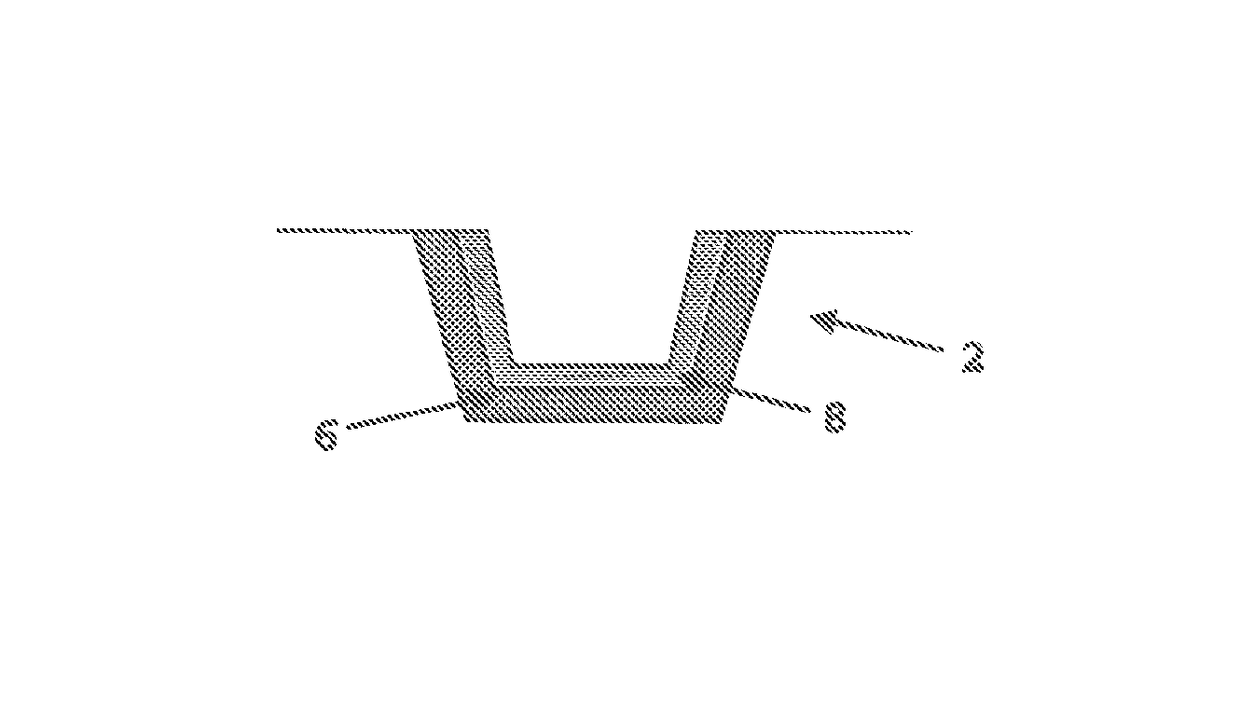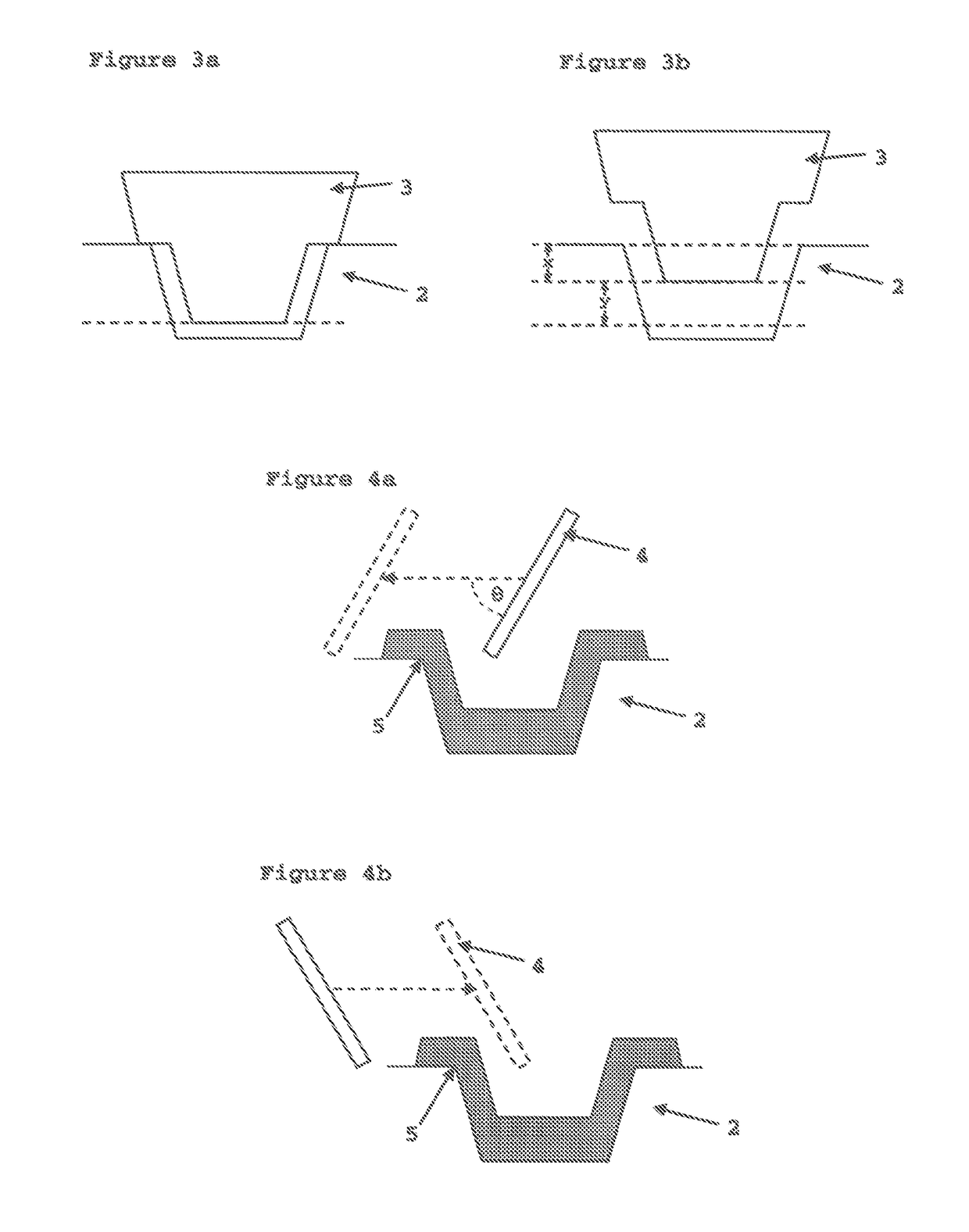Method for manufacturing confectionery shells
a technology of confectionery shells and manufacturing methods, applied in confectionery, cocoa, food science, etc., can solve the problems of significant cost saving and downtime of machinery, and achieve the effect of less clean edges
- Summary
- Abstract
- Description
- Claims
- Application Information
AI Technical Summary
Benefits of technology
Problems solved by technology
Method used
Image
Examples
example 1
[0105]Tempered Milka® chocolate mass (55 g, manufactured by Kraft Foods) was manually deposited at 30° C. into a cavity of a stamp mould (Brunner-Glonn, Germany), the mould having been stored in a heating cabinet for 2 days at 30° C. The mould was vibrated for 30 seconds to even the surface of the chocolate mass inside the mould cavity.
[0106]The chocolate mass was then pressed in the mould cavity using a Knobel® Cold Stamp Unit (CP Standard Cold Press Type 07-KCM-09, Knobel, Felben CH). The immersion period was set to 7 seconds, the surface of the stamp was −5° C. and the speed was 60 mm s−1. The stamp was pressed into the cavity to its fullest extent (i.e. the position of the stamp corresponded to y=0 mm in FIG. 3b).
[0107]The stamp was withdrawn and the mould was stored at ambient temperature for 5 minutes. Next, tempered Milka® white chocolate mass (45 g) was manually deposited into the mould cavity at 30° C. The white chocolate mass was then pressed in the mould cavity using the ...
example 2
[0109]Example 2 was conducted in the same manner as Example 1 except that a scraping step was performed prior to removing the confectionery shell from the mould in order to remove edible material ejected from the mould cavity in the pressing steps. Scraping was conducted in two scraping actions using a metallic knife as the scraping means and the scraping was conducted at ambient temperature and an applied scraping angle of 45°. One scraping action was made from the middle of the mould cavity along the long sides and outwards over one of the short sides (i.e. motion ‘b’ in FIG. 6b) and one scraping action from the middle of the mould cavity along the long sides and outwards over the other short side (i.e. motion ‘c’ in FIG. 6b).
[0110]Following removal from the mould cavity, visual inspection of the confectionery shell revealed a similar structure to that obtained in Example 1, except that the open end of the confectionery shell had a smoother edge on account of excess material being...
example 3
[0111]Example 3 was conducted in the same manner as Example 2, except that the scraping step comprised four scraping actions. The four scraping actions were made from the middle of the mould cavity outwardly across each of the four sides of the mould cavity (i.e. motions ‘b’ and ‘c’ in FIG. 6b and motions ‘d’ and ‘e’ in FIG. 6c).
[0112]Following removal from the mould cavity, visual inspection of the confectionery shell revealed a similar structure to that obtained in Example 1 and Example 2, except that the open end of the confectionery shell had a yet smoother edge on account of excess material being removed by scraping. In particular, the edge along all sides of the confectionery shell was free of defects.
PUM
| Property | Measurement | Unit |
|---|---|---|
| scraping angle | aaaaa | aaaaa |
| scraping angle | aaaaa | aaaaa |
| diameter | aaaaa | aaaaa |
Abstract
Description
Claims
Application Information
 Login to View More
Login to View More - R&D
- Intellectual Property
- Life Sciences
- Materials
- Tech Scout
- Unparalleled Data Quality
- Higher Quality Content
- 60% Fewer Hallucinations
Browse by: Latest US Patents, China's latest patents, Technical Efficacy Thesaurus, Application Domain, Technology Topic, Popular Technical Reports.
© 2025 PatSnap. All rights reserved.Legal|Privacy policy|Modern Slavery Act Transparency Statement|Sitemap|About US| Contact US: help@patsnap.com



